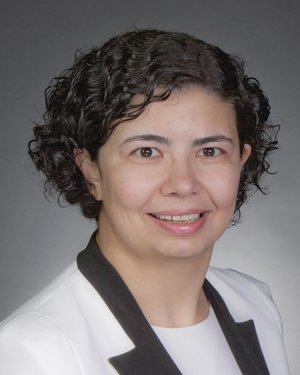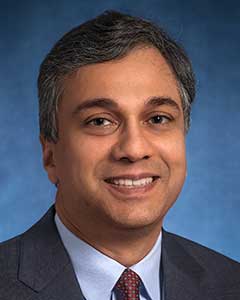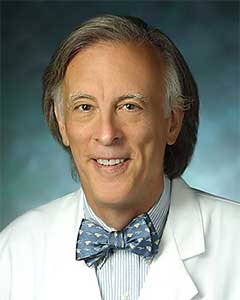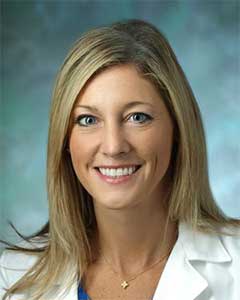-
Ayse P. Gurses, Ph.D., M.S.

- Director, Armstrong Institute Center for Health Care Human Factors
- Professor of Anesthesiology and Critical Care Medicine
- Joint Appointment in Medicine
- Professor of Emergency Medicine
Research Interests: Usability, Qualitative research, Survey design, Coordination, Handoffs, Medical informatics, Industrial and systems engineering, Patient safety, Human factors engineering
-
Michael A. Rosen, Ph.D., M.A.

- Professor of Anesthesiology and Critical Care Medicine
Research Interests: Behavioral markers of team performance, Naturalistic decision making, Performance measurement, Simulation-based training, Teamwork, Patient safety
Our Team: Center for Health Care Human Factors
About Human Factors in Health Care
Health care professionals are among the most highly trained, driven and conscientious professionals. So, how is it that medical errors are a major public health problem and patients do not consistently receive evidence-based care?
Despite their education and desire to deliver the best care possible, health care professionals can be set up for mistakes by poorly designed medical devices, uncoordinated care processes and fragmented systems. Too often, these systems are designed in a way that do not account for how people actually interact with their work environment.
Human beings have limited attention spans. We perform worse when we are tired. We can only focus on one thing at time. We forget things. When systems ask us to go beyond these and other limits, failures can occur.
Urging clinicians to “try harder” or “be more careful” will not safeguard them against errors. Likewise, efforts to improve care solely through education often have minor and fleeting improvements, if any. To reduce or prevent such harms, the health care environment must be designed with human limitations and abilities in mind.
This is the focus of human factors, a scientific discipline that aims to help people do their best work, improve resilience and overall system performance, and minimize errors. Human factors-based solutions make it “easy to do things right and hard to do things wrong.” When errors do occur, they are less likely to lead to patient harm.
Applications of Human Factors in Health Care
In health care, human factors specialists seek to improve people-system interactions for everyone involved – health care professionals, patients and family members. Their work can be focused on enhancing the safety and usability of a single product – such as a medical device – or on improving an entire care delivery process or organizational structure (e.g. leadership, supply-chain management, etc.). These specialists seek to understand the myriad factors that affect performance of the system — the physical environment; tasks, tools and technologies involved; and the organizational conditions in which the work occurs — and then redesign systems to improve patient safety and team performance.
These methods can be used to:
- minimize clinician error
- improve clinician performance
- increase delivery of evidence-based medicine
- enhance patient- and family-centeredness of care
- improve patient-provider communication
- reduce inefficiencies and non-value adding tasks
- reduce burnout and improve clinicians' job satisfaction
While human factors approaches have been used for decades in complex, high-risk fields such as aviation and nuclear power, their introduction to health care was limited until the Institute of Medicine's 1999 landmark report, "To Err is Human: Building a Safer Health Care System." Even today, these approaches are not widely adopted, and more work is needed to integrate human factors methods and tools into health care improvement work.
Human Factors in Action: Examples from the Field
Safe Medication Storage
Multidose insulin pens are required to be placed in patient-specific containers in a medication room, per both Johns Hopkins and Joint Commission requirements. However, patient needs, physician requests, phone calls and other interruptions often caused nurses to put the pens in their pockets and make a mental note to return them later. This practice led to medication errors.
Working with a human factors engineer, a unit-based safety team devised, installed and evaluated clear plastic lockboxes in each patient’s room to hold an insulin pen.
Improving Safety of Cardiac Surgery
Human factors engineers, clinicians, outcomes researchers, psychologists and sociologists sought to proactively identify safety risks in cardiac surgery using a multi-method approach, including observations of 22 surgeries at five well-respected hospitals. Their holistic review uncovered 58 different types of hazards — anything in the work system that has the potential to cause an error — related to flawed devices, suboptimal physical layout design, processes and organizational structures. Hazards included disorganized medication carts that might lead a clinician to select the wrong drug, a surgeon who was introduced to a new cautery gun in the middle of a procedure, and purchasing practices that did not consider the downstream safety impacts of their decisions. Many of the team’s recommendations were adopted by the five hospitals, resulting in improvements in areas such as infection prevention and safety of care transitions.
Preventing Infusion Pump Errors
There were instances in which the tubing from an infusion pump would come into contact with the pump’s touch screen, leading to accidental changes in the rate of infusion. Working with a human factors engineer, the team added a Plexiglas, see-through guard that enables clinicians to move the tubing without accidentally changing the pump’s settings.
“Human factors and ergonomics must play a more prominent role in health care if we want to increase the pace in improving patient safety.”
- Gurses AP, Ozok AA, Pronovost PJ. “Time to accelerate integration of human factors and ergonomics in patient safety.” BMJ Qual Saf 2012; 21:347-351.
Ayse P Gurses, Ph.D., M.S. , M.P.H
Director, Armstrong Institute Center for Health Care Human Factors, Armstrong Institute, Johns Hopkins Medicine, Schools of Medicine, Bloomberg Publish Health, Whiting Engineering, Johns Hopkins University
Google Scholar
Dr. Gurses is a globally recognized researcher, educator, and thought leader in infusing human factors engineering principles and methods into health care with the goal to design better and safer work environments and systems for improving patient safety and health care worker safety. She is the Founding Director of the Center for Health Care Human Factors at the Johns Hopkins Armstrong Institute and Professor in the Johns Hopkins University Schools of Medicine, Bloomberg Public Health and Whiting Engineering. She is the author of more than 100 peer-reviewed publications on human factors engineering, human-centered design, usability evaluation, patient safety and quality of care, and health care worker safety. She has been a principal or co-principal investigator on several research grants and contracts (funded by CDC, AHRQ, NIH, NSF, other multiple foundations and private institutions), totaling over $17M (as of October 2022).
Dr. Gurses’s current research efforts include, but not limited to human-centered and health-IT based clinical work system design, modeling cognitive and team work to improve diagnostic safety in emergency department, re-engineering complex work systems to reduce healthcare-associated infections, improving safe management air flow and aerosol generating procedures in the operating rooms to reduce infection transmission, improving safety of care transitions/ handoffs, and using human factors-based approaches to improve patient-care professional partnership for improving medication safety. Dr. Gurses has conducted research in a variety of care settings, including hospitals, ambulatory care, long-term care, and home care, as well as transitions of care between these settings. Dr. Gurses served as a member of an ad-hoc National Academies Committee on a 2-year effort that produced the 2022 report titled “Frameworks for Protecting Workers and the Public from Inhalation Hazards.” She also served as an Editor/ Scientific Editor for several journals in her field of expertise and currently is an Executive Committee Member of the Human Factors and Ergonomics Society. Dr. Gurses received multiple awards for her contributions to the science of safety, including the Federation of Associations in Behavioral and Brain Sciences Foundation Award, Liberty Mutual Award on Safety, and the International Ergonomics Association Best Paper Award in Occupational Safety and Ergonomics.
In addition to advancing the science of safety, Dr. Gurses’s health care human factors program has had a wide practical impact in the frontline clinical work. For example, when the Ebola epidemic hit in 2014, she led the Johns Hopkins Armstrong Institute’s efforts in partnering with the CDC to develop a web-based training to prepare health care professionals for potential Ebola cases by integrating human factors and industrial engineering, implementation science, and public health principles and methods with infection control and prevention and clinical expertise. Currently, as part of the CDC’s Project Firstline Initiative, and in collaboration with the JHU Applied Physics Laboratory, Dr. Gurses is leading a large-scale, multidisciplinary, innovative project aimed at improving infection prevention and control in the peri-operative work systems using engineering-based approaches across the nation.

Patience Osei, M.S.E.
Quality and Innovation Project Manager
Google Scholar
Patience is the Quality and Innovation Project Manager on the Human Factors team at the Johns Hopkins Armstrong Institute for Patient Safety and Quality. With her background in biomedical engineering, innovation and design, she has led the research and scientific implementation of several grant-funded studies at the center, aimed at improving patient safety in various health care settings. Her work has been specific to infection prevention and control, diagnostic safety and medication safety in the hospital, nursing home and home-care settings. She is currently responsible for managing projects at the Center for Health Care Human Factors. Her research interests include the application of human factors principles to infection prevention and control.
EducationB.S., Biomedical Engineering, Bucknell University, 2014
M.S.E., Bioengineering Innovation and Design, Johns Hopkins University, 2015
Certificate Programs
Patient Safety Certification, Armstrong Institute for Patient Safety and Quality, 2017
Patient Safety Leadership Academy Certification, Armstrong Institute for Patient Safety and Quality, 2019
Research Interests
Innovation; Design; Qualitative Research; Infection Prevention; Biomedical and Systems Engineering; Patient Safety; Human Factors Engineering, Usability

Lamia Alam, Ph.D.
Google Scholar
Postdoctoral Research Fellow
Lamia is a Postdoctoral Research Fellow on the Human Factors team at the Johns Hopkins Armstrong Institute for Patient Safety and Quality. She is a Cognitive Scientist with experience in behavioral studies and human factors engineering within healthcare settings, artificial intelligence (AI) for diagnostic tools, and user experience. Her research interests include investigating cognitive processes of healthcare professionals using mixed-method approaches, patient perspectives about health informatics, developing tools and techniques to improve human-AI team dynamics within healthcare.
EducationB.S., Computer Science and Engineering, Military Institute of Science and Technology, Bangladesh, 2014
M.S., Applied Cognitive Science and Human Factors, Michigan Technological University, 2020
Ph.D., Applied Cognitive Science and Human Factors, Michigan Technological University, 2022

Oluseyi Daodu, M.S.
Senior Research Program Coordinator
Google Scholar
Oluseyi is the Senior Research Program Coordinator on the Human Factors team at the Johns Hopkins Armstrong Institute for Patient Safety and Quality. She is a Biotechnologist with experience in conducting early phase drug and device studies, biomolecule crystallization, and project management. She is also responsible for the team’s IRB related processes. Her research interests include patient safety, infection prevention and control.
Education B.S, Biological sciences, Morgan State University, 2017 M.S, Biotechnology, Johns Hopkins University, 2021
Emma MacIntyre, B.S.
Senior Research Program Coordinator
Emma is a part-time Senior Research Program Coordinator on the Human Factors team at the Johns Hopkins Armstrong Institute for Patient Safety and Quality. She works as an engineer at Insulet Corporation. She has experience working in multiple engineering disciplines including human factors engineering. Her interests lie in the application of human factors engineering in healthcare and the medical device industry.
Education B.S., Biomedical Engineering and Mechanical Engineering, Worcester Polytechnic Institute, 2018 M.S., Applied Biomedical Engineering, Johns Hopkins University, 2023 (Expected)
Jessica
Research Assistant
Jessica is a Research Assistant on the Human Factors team at the Johns Hopkins Armstrong Institute for Patient Safety and Quality. She works on qualitative data analysis and modeling. Her prior experience concerns health communication, education, and project management. She is interested in finding ways to improve public scientific literacy, as well as infection prevention and control mechanisms.
Education B.A., Public Health Studies and Visual Arts, Johns Hopkins University, 2023 (Expected)
HF Experts
Affiliate Members
Allen Kachalia, M.D., J.D.
Director, Armstrong Institute for Patient Safety and Quality
Senior Vice President for Patient Safety and Quality, Johns Hopkins Medicine
Professor of Medicine, The Johns Hopkins University School of Medicine

Peter Najjar, M.D., M.B.A.
Medical Director for Clinical Operations, Armstrong Institute for Patient Safety & Quality
Assistant Professor of Surgery, The Johns Hopkins University School of Medicine

Jim Fackler, M.D.
Professor of Anesthesiology and Critical Care Medicine, The Johns Hopkins University School of Medicine

Matthew Stewart, M.D., Ph.D.
Associate Professor of Otolaryngology - Head and Neck Surgery, The Johns Hopkins University School of Medicine

Kathy McDonald, Ph.D.
Co-Director, Armstrong Institute Center for Diagnostic Excellence
Bloomberg Distinguished Professor
Professor of Medicine, The Johns Hopkins University School of Medicine, Johns Hopkins School of Nursing

Sara Keller, M.D., M.P.H., M.S.P.H.
Associate Professor of Medicine, The Johns Hopkins University School of Medicine

Morgan Katz, M.D., M.H.S.
Assistant Professor of Medicine, The Johns Hopkins University School of Medicine

Susan Peterson, M.D.
Associate Medical Director for Patient Safety and Quality, The Johns Hopkins Hospital
Department of Emergency Medicine Associate Faculty, The Johns Hopkins University School of Medicine
Assistant Professor of Emergency Medicine, The Johns Hopkins University School of Medicine

Richard Rothman, M.D., Ph.D.
Vice Chair of Research, Department of Emergency Medicine, The Johns Hopkins Hospital
Director, Research Fellowship, Department of Emergency Medicine, The Johns Hopkins Hospital
Director, Residency Research, Department of Emergency Medicine, The Johns Hopkins Hospital
Professor of Emergency Medicine, The Johns Hopkins University School of Medicine
Joint Appointment in Medicine

James Abernathy, M.D., M.P.H.
Associate Professor of Anesthesiology and Critical Care Medicine, The Johns Hopkins University School of Medicine

Valeria Fabre, M.D.
Associate Professor of Medicine, The Johns Hopkins University School of Medicine

Sara Karaba, M.D., Ph.D., M.H.S.
Assistant Professor of Medicine, The Johns Hopkins University School of Medicine
- Heather Saunders
Infection Preventionist, Nurse - Svea Closser
Anthropologist - Nancy Edwards
Senior administrator
- Chris Halligan
Grants manager - Ray Terhorst
Instructional Designer - Angie Sims
Management
Collaborators
- Shawna J. Perry, M.D.
SJP Consulting LLC - Gary Klein, Ph.D.
ShawdowBox LLC and Macrocognition LLC - Emily M. Roth, Ph.D.
Roth Cognitive Engineering - Laura Militello, M.A.
Applied Decision Science LLC - Cynthia Leaphart, M.D.
CL Square Consulting, PLLC - Alison Trinkoff, Ph.D.
University of Maryland - Brian Damit
Applied Physics Laboratory, JHU - Jeffrey Freeman, Ph.D., M.P.H.
Applied Physics Laboratory, JHU
- Susan Hallbeck, Ph.D.
Mayo Clinic - Elena Beam
Mayo Clinic - Eric Eisenberg, Ph.D.
University of South Florida - Hugo Sax, M.D.
University of Zurich - Heather Tubbs Cooley, Ph.D.
The Ohio State University - Dan France, Ph.D., M.P.H.
Vanderbilt University - Yan Xiao, Ph.D.
The University of Texas at Arlington - Mary-Claire Roghmann, M.D., M.S.
University of Maryland

